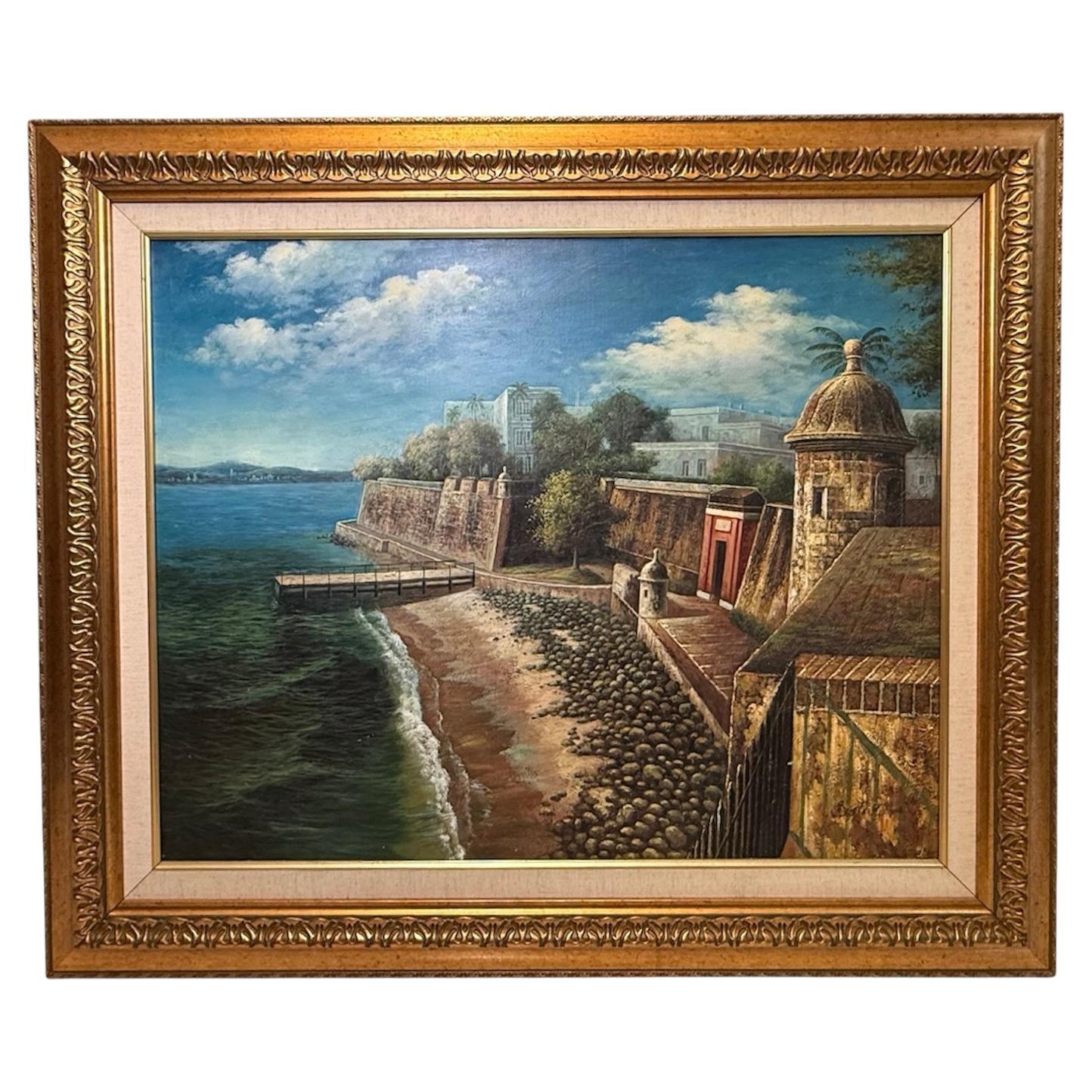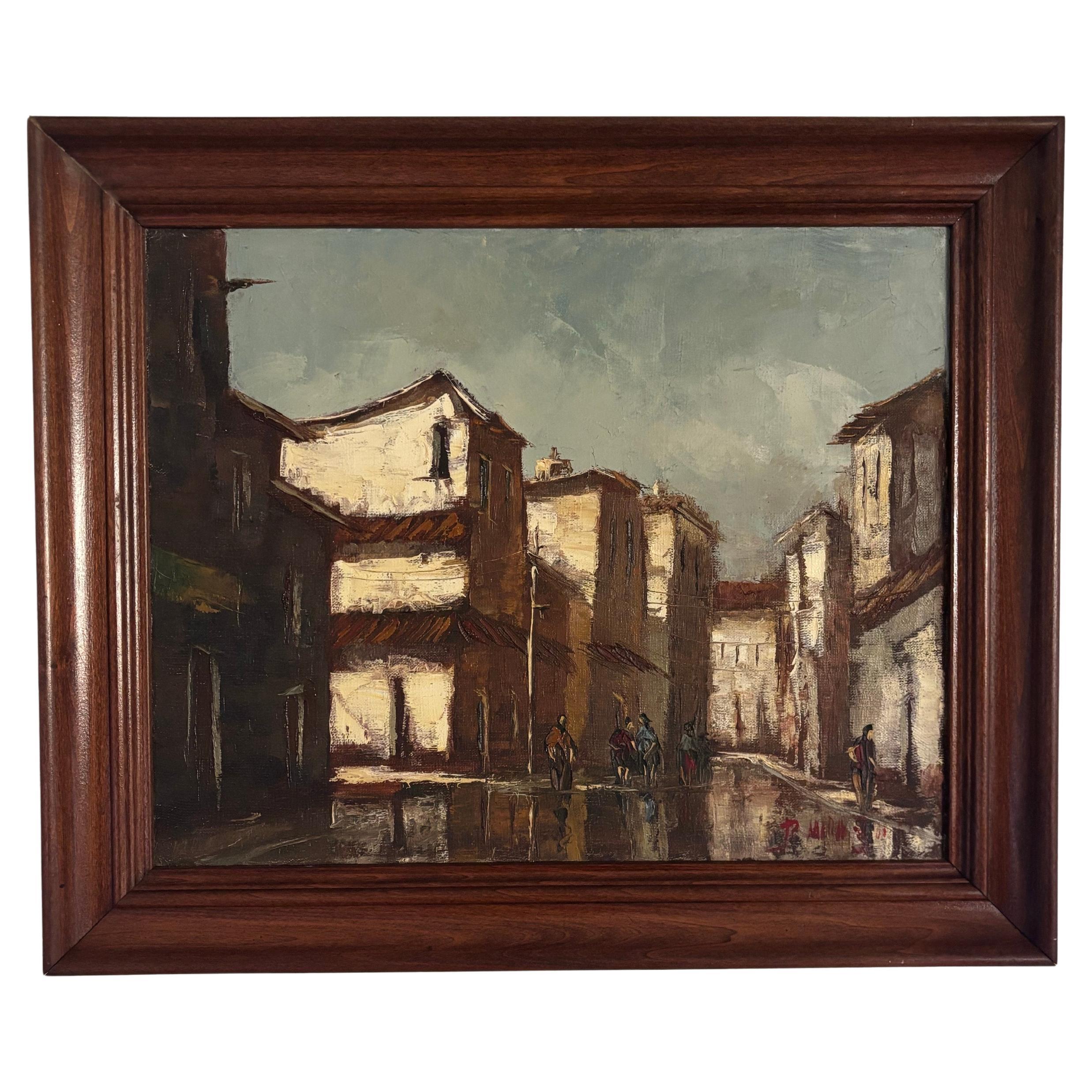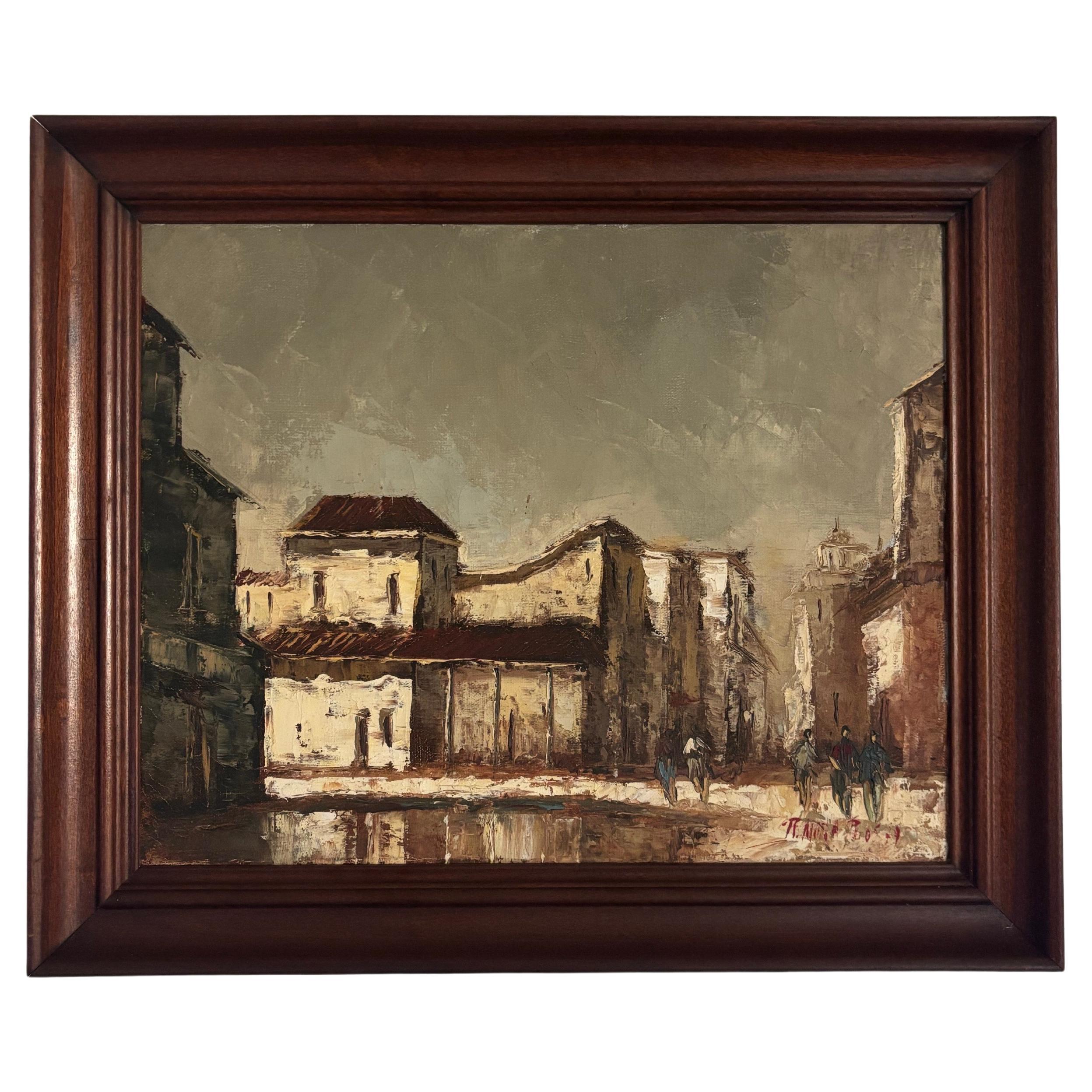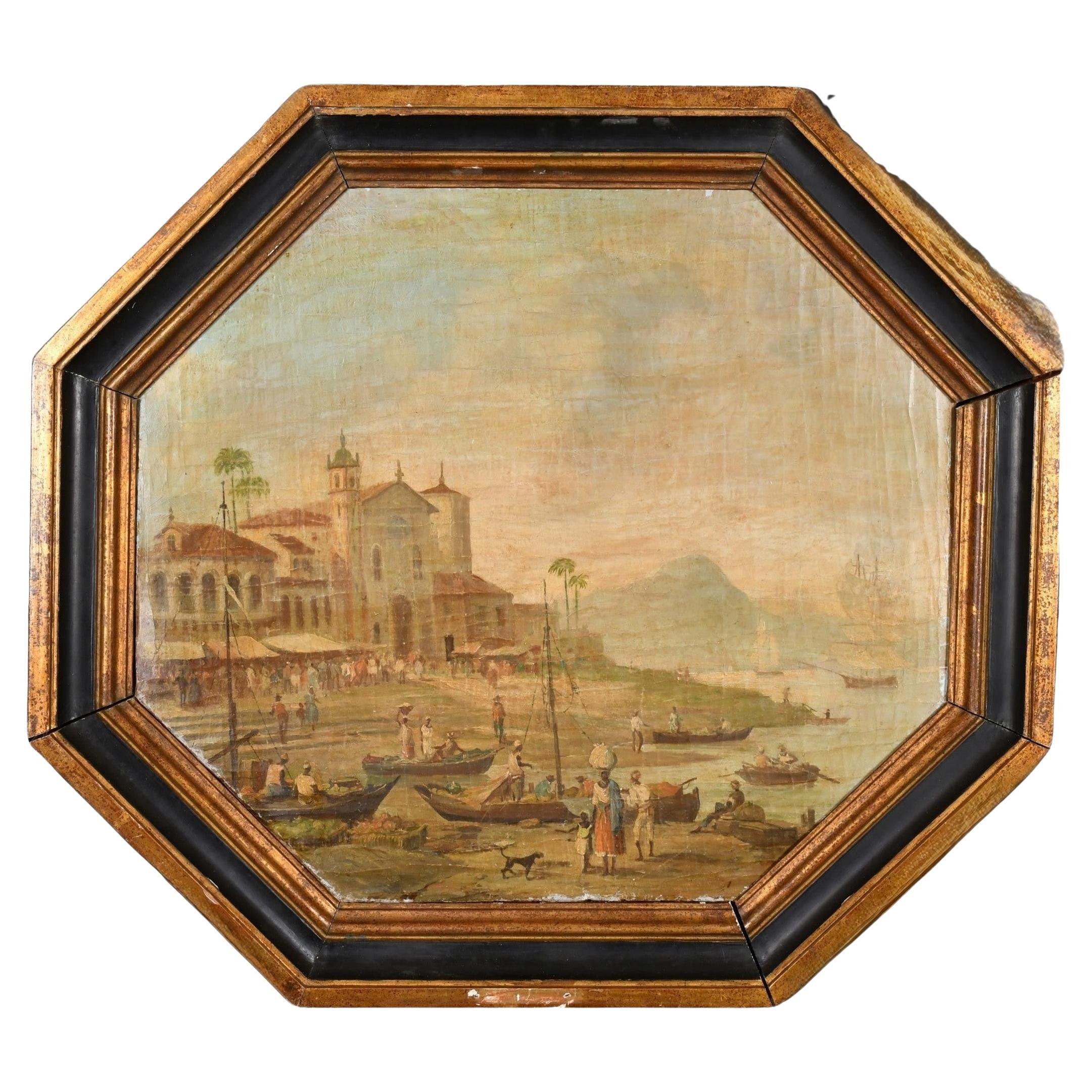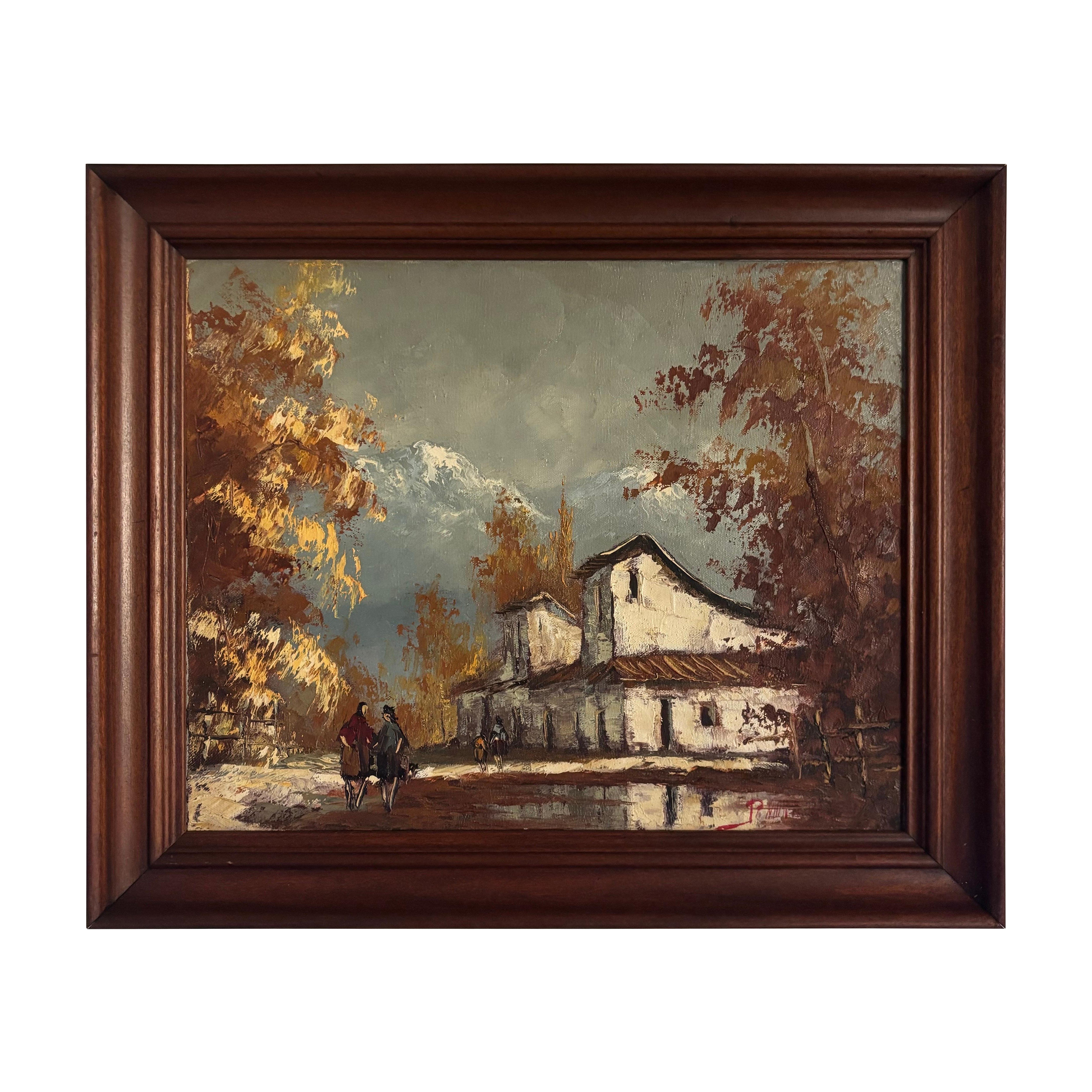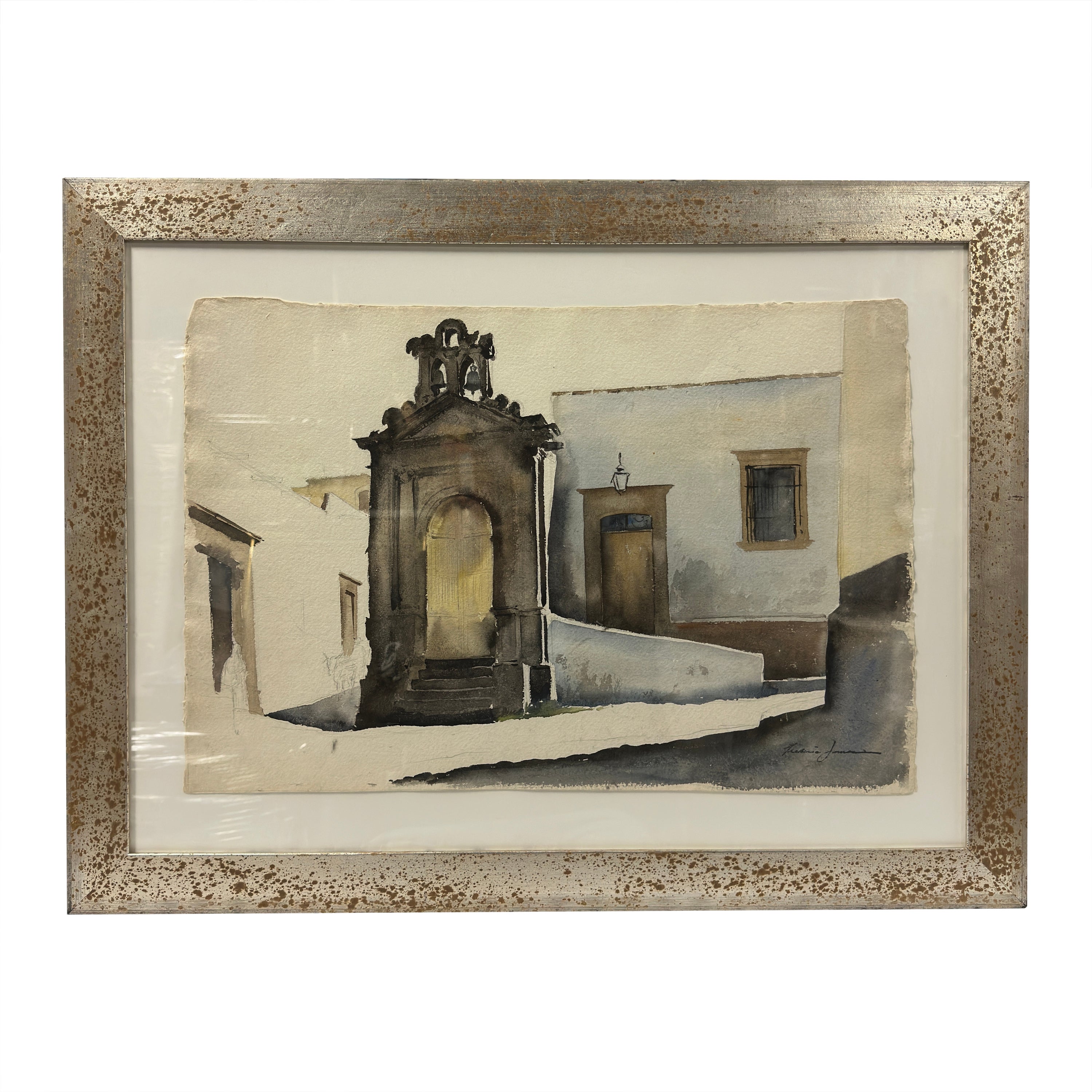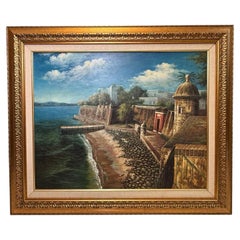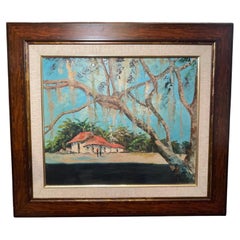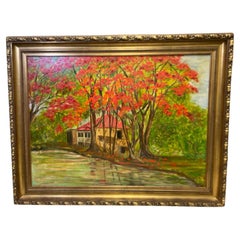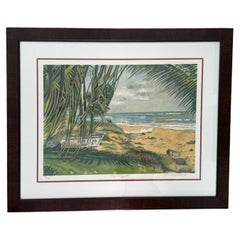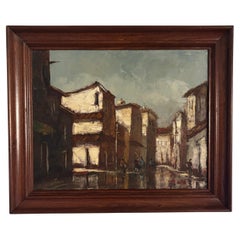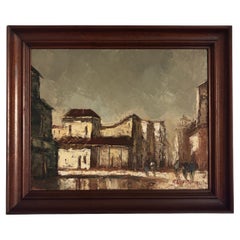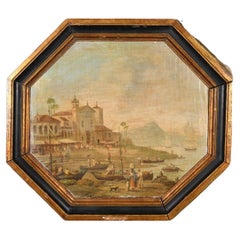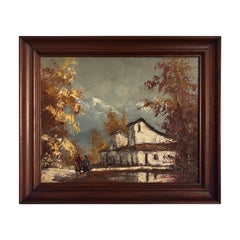Items Similar to An Old San Juan “ La Escalinata del Hospital “ Painting
Want more images or videos?
Request additional images or videos from the seller
1 of 16
An Old San Juan “ La Escalinata del Hospital “ Painting
$2,595
£1,956.89
€2,263.23
CA$3,640.77
A$4,046.94
CHF 2,121.32
MX$49,422.97
NOK 26,483.47
SEK 24,916
DKK 16,892.12
About the Item
This is an Oil Painting of a place in the Old San Juan, Puerto Rico. It depicts a long staircase that is called “ La Escalinata del Hospital “or “La Escalinata de Las Monjas’ between colorful buildings with Spaniard architecture. A long balcony stands out from the upper part of one of the buildings at the left. A sign hanging from the guardrail of this balcony read: “ Ladies for rent for single men”. The name comes because a former hospital of San Juan was built nearby and there was also a nunnery, that became a hotel that is known today as El Convento Hotel. There are some planters with green plants adorning the staircase. A man with a backpack is climbing the stairs. An antique headlight comes out from the wall of another building. The painting is mounted in a gold color wood frame that its border is decorated with carved eggs and Fleur de Lis. It is signed by the painter-Sanchez Felipe at the left side. Alejandro Sánchez Felipe ( 1888- 1971 ) was a Spaniard painter and educator who lived in Puerto Rico since 1933. He was the director of the Art school in the Old San Juan and many of our most talented artists like Augusto Marín, Fran Cervoni and Rafael Tufiño studied with him. His realistic paintings depict the urban landscape of San Juan. Art Painting measures: Height: 27.75 in and Width: 20.25 in.
- Dimensions:Height: 35.5 in (90.17 cm)Width: 31 in (78.74 cm)Depth: 2 in (5.08 cm)
- Style:Romantic (In the Style Of)
- Materials and Techniques:
- Place of Origin:
- Period:
- Date of Manufacture:1970
- Condition:Wear consistent with age and use.
- Seller Location:Guaynabo, PR
- Reference Number:1stDibs: LU5431245330652
About the Seller
5.0
Platinum Seller
Premium sellers with a 4.7+ rating and 24-hour response times
Established in 2011
1stDibs seller since 2020
369 sales on 1stDibs
Typical response time: <1 hour
- ShippingRetrieving quote...Shipping from: Guaynabo, PR
- Return Policy
Authenticity Guarantee
In the unlikely event there’s an issue with an item’s authenticity, contact us within 1 year for a full refund. DetailsMoney-Back Guarantee
If your item is not as described, is damaged in transit, or does not arrive, contact us within 7 days for a full refund. Details24-Hour Cancellation
You have a 24-hour grace period in which to reconsider your purchase, with no questions asked.Vetted Professional Sellers
Our world-class sellers must adhere to strict standards for service and quality, maintaining the integrity of our listings.Price-Match Guarantee
If you find that a seller listed the same item for a lower price elsewhere, we’ll match it.Trusted Global Delivery
Our best-in-class carrier network provides specialized shipping options worldwide, including custom delivery.More From This Seller
View AllSixto Febus Oil Painting of Old San Juan Historic Fortress San Felipe Del Morro
By Sixto Febus
Located in Guaynabo, PR
This is an oil painting made by Sixto Febus (1918-2010). He was a Puertorican painter who was very known in Europe as an art restorer. He worked in the royal collection of Buckingham...
Category
20th Century American Romantic Paintings
Materials
Canvas
Oil Canvas Of A Banana Plantation Countryside House
Located in Guaynabo, PR
This is an Oil Painting of a Banana Plantation Countryside House. It depicts several branches of an oak tree with moss hanging from it. In the center, far away from the oak tree, the...
Category
20th Century Paintings
Materials
Canvas
20th Century Countryside Oil Canvas Painting
Located in Guaynabo, PR
This is an Oil Canvas Countryside Scene Painting by Leonor. It depicts a large and blossom Flamboyant tree in front of a country house. The water of a lake near the house reflected t...
Category
20th Century Unknown Country Picture Frames
Materials
Canvas, Wood
$2,800 Sale Price
20% Off
Puerto Rican Luquillo Beach Silk Screen Print
Located in Guaynabo, PR
This is a Silk-Screen Print of the Luquillo Beach in Puerto Rico by Torres De la Haba. It depicts a typical scene of a sunny day in an area of the beach where there is a fishing boat...
Category
20th Century American Paintings
Materials
Glass, Wood
20th Century, Elaine Vollherbst the Joy of Life I Acrylic Canvas Painting
Located in Guaynabo, PR
This is an Elaine Vollherbst, lane acrylic canvas painting. It is called The Joy of Life I. It is a very large rectangular framed painting that depic...
Category
Late 20th Century American Romantic Paintings
Materials
Wood
$3,040 Sale Price
49% Off
Lecon D’Amour Oil Painting By Miguel Pou After Jean-Gabriel Domergue
Located in Guaynabo, PR
This is Lecon D’Amour Oil Painting By Miguel Pou after Jean-Gabriel Domergue. It depicts a 19th century lady attired with a coral satin long skirt gown with lace in its sleeves who is seated in a baluster porch rail looking at a gentleman who is kissing her hand behind it. There is a late Autumn tree behind them. Far away, a lake or a river, more Autumn trees and mountains can be seen. The original painting appeared in the cover of a periodical named L’Illustration from 1913. The painting is signed M.Pou 1937 in the left lower corner and G.Domergue at the right one. It is mounted in an oval gilt bronzed color wood frame that is decorated with a large bow at the top. Miguel Pou Becerra ( 1880 - 1968 ) was a Puerto Rican painter, draftsman and educator who is considered together with Jose Campeche and Francisco Oller...
Category
Early 20th Century American Romantic Paintings
Materials
Canvas
You May Also Like
Original Oil Painting by José Alberto Mora, Venezuela, circa 1970s
Located in Boynton Beach, FL
Beautiful original oil painting done by Venezuelan artist José Alberto Mora. Neutral colors create a moody depiction of a Venezuelan town. Beiges and dark browns create a depth of em...
Category
Mid-20th Century Venezuelan Rustic Paintings
Materials
Canvas, Wood
Vintage Original Oil Painting by José Alberto Mora, Venezuela, 1970s
Located in Boynton Beach, FL
Beautiful original oil painting done by Venezuelan artist José Alberto Mora. Neutral colors create a moody depiction of a Venezuelan town. Beiges and dark browns create a depth of em...
Category
Mid-20th Century Venezuelan Rustic Paintings
Materials
Wood, Paint
Early 19th century Capriccio Brazil School Painting
Located in Seaford, GB
Rare Early 19th century Capriccio view of Rio de Janeiro Painting
Probably painted circa 1810 by one of Jean-Baptiste Debret, Italian Students.
Painted on Sailcloth.
Historical Context of Early 19th Century Portuguese Colonial Brazil
1.1 Transition from Colony to Empire
During the early 19th century, Brazil underwent a seismic shift in its political status. Originally a colony under the Portuguese Empire, the arrival of the Portuguese Royal Court in Rio de Janeiro in 1808 rapidly elevated the city’s cultural and political importance. By 1815, Brazil was declared a kingdom united with Portugal, setting the stage for the emergence of the Empire of Brazil in 1822. This period of transformation—often termed the transitional period from colony to empire—fueled a wave of artistic production in cities like Rio de Janeiro.
1.2 European Artistic Influence in Brazil
With the French Artistic Mission in Rio (initiated in 1816) and the presence of various Portuguese and European artists, Brazilian art of the early 1800s began to reflect diverse influences, from neoclassical painting to the early rumblings of romanticism. Painters such as Jean-Baptiste Debret, and Nicolas-Antoine Taunay, and local luminaries like Manuel de Araújo Porto-Alegre contributed to the fine arts tradition in Brazil. Their works featured scenes of local life, portraits of Brazilian society, and imaginative vistas—sometimes referred to as “capriccios,” in which real elements were combined with artistic liberties to create an idealized panorama.
1.3 Rio de Janeiro as Cultural and Political Hub
Rio de Janeiro, often called the Imperial capital after Brazil’s independence, was home to foundational institutions like the Imperial Academy of Fine Arts (Academia Imperial de Belas Artes). Later evolving into the Escola de Belas Artes (School of Fine Arts in Rio), these academies nurtured the talents of emerging painters, who found patronage under the Royal Court and, subsequently, the Imperial Court. The city’s significance was further enhanced by the construction of significant buildings, the modernization of infrastructure, and the mingling of European courtly customs with the traditions of local inhabitants.
. Description of the Octagonal Oil on Canvas: A Capriccio View of Rio de Janeiro
2.1 Composition and Layout
The most striking characteristic of this 19th-century Brazilian art piece is its octagonal shape, a relatively unusual format that draws the viewer’s gaze toward its centre. The composition showcases Rio de Janeiro’s shoreline in the early 1800s, brimming with merchant ships and smaller boats anchored near the shore. On the sand, there is a bustling crowd of local people—men and women carrying food and goods on their heads, loading and unloading boats, and engaging in everyday commerce. The backdrop of soaring mountains suggests Rio’s iconic topography, embodying the landscape that famously defines the city.
2.2 Architectural and Religious Landmarks
On the left side, one can discern the silhouette of a church believed to be Santa Lucia, a significant religious structure in the heart of early 19th-century Rio. This element provides viewers with a tangible reference point, linking the scene to an actual location. However, because this painting is labelled as a “capriccio,” the artist might have taken creative liberties by rearranging or amplifying certain features of the city. The melding of real and idealized elements is characteristic of these imaginative vistas.
2.3 Evoking Daily Life in Colonial Rio
One of the painting’s greatest appeals lies in its portrayal of daily life during the colonial era. Men and women from various backgrounds populate the scene. Some appear to be carrying goods on their heads, a common practice in Brazil that has persisted through different centuries. Others appear to be haggling or trading near small vessels, revealing the commercial pulse of an active port city. This focus on local people, combined with the grandeur of merchant ships, captures the tension and synergy between the every day and the extraordinary—a hallmark of Brazilian colonial painting that balances the grand narratives of empire with the rhythms of ordinary life.
2.4 An Amalgamation of Neoclassical and Romantic Influences
Although academic art in early 19th century Brazil was highly influenced by neoclassicism, the onset of romanticism can be spotted in the emotional portrayal of the sky, the lively palette, and the dramatic emphasis on nature’s beauty (the mountains, in particular). This duality reflects the fine arts tradition in Brazil during the transitional phase when artists were embracing multiple styles. As part of the School of Rio or the Rio de Janeiro school, painters often integrated academic techniques learned from European masters with emerging local subjects and influences.
3. Institutions and Artistic Movements
3.1 Imperial Academy of Fine Arts
Originally known as the Royal School of Sciences, Arts, and Crafts, the Imperial Academy of Fine Arts in Rio de Janeiro was instrumental in shaping 19th-century Brazilian art. Influential artists and teachers from Portugal, France, and other European nations congregated at the Academy, imparting their expertise to native students. As the monarchy consolidated power, the Academy enjoyed royal patronage, leading to the creation of Imperial Academy-style works that combined European academic rigour with Brazilian-themed subject matter.
3.2 Impact of the French Artistic Mission
The French Artistic Mission, which arrived in 1816, played a pivotal role in introducing advanced European artistic techniques, thereby elevating the overall quality of painting in Brazil. Artists like Jean-Baptiste Debret not only documented Brazilian society but also spearheaded the development of a local visual identity that aligned with both academicism and the national context of a blossoming empire. Debret, alongside others such as Nicolas-Antoine Taunay, mentored Brazilian artists, sowing the seeds of what would become the Brazilian academic art movement.
3.3 Religious, Historical, and Landscape Paintings
In addition to everyday scenes and historical compositions, religious iconography remained crucial throughout Portuguese colonial and imperial Brazil. Churches were omnipresent in cityscapes like Rio de Janeiro. Many colonial-era Brazilian portraits...
Category
Antique Early 19th Century Brazilian Spanish Colonial Paintings
Materials
Canvas
$2,979 Sale Price
20% Off
Vintage Original Oil Painting by José Alberto Mora, Venezuela, 1970s
Located in Boynton Beach, FL
Beautiful original oil painting done by Venezuelan artist José Alberto Mora. Neutral colors create a moody depiction of a Venezuelan town. Beiges and dark browns create a depth of em...
Category
Mid-20th Century Venezuelan Rustic Paintings
Materials
Wood, Paint
Early 20th Century Framed Architectural Painting
Located in Houston, TX
The Early 20th Century Framed Architectural Painting depicts a grand building or home with intricate architectural details characteristic of that era. The painting is expertly execut...
Category
Early 20th Century Unknown Mid-Century Modern Paintings
Materials
Canvas, Paint
Whimsical Oil on Board of European Town Signed Spinola
Located in Tarrytown, NY
Whimsical small oil on board painting of a European town. Signed Spinola. Out of. Southampton, NY estate.
Category
Vintage 1960s Paintings
Materials
Paint
More Ways To Browse
Ladies Backpack
Vintage Canvas Backpack
Fleur De Lis Planter
Ladies Backpack
Vintage Canvas Backpack
Ladies Backpack
Vintage Canvas Backpack
Ladies Backpack
Vintage Canvas Backpack
Ladies Backpack
Vintage Canvas Backpack
Upper West Side Apartment
Holophane Wall Sconce
Neo Classicism Style
Paul Smith Pillow
Paul Smith Throw
Wet Rated Sconces
Kazuhide Takahama For Cassina
